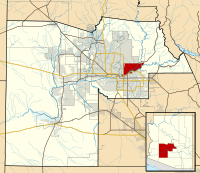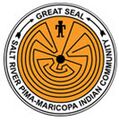Salt River Pima–Maricopa Indian Community facts for kids
| Onk Akimel O'odham Xalychidom Piipaash |
|
|---|---|
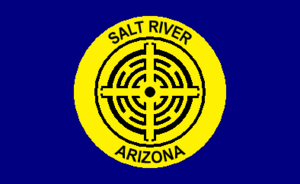
Tribal Flag
|
|
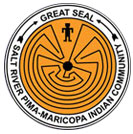
SRPMIC Seal
|
|
| Total population | |
| 9,357 | |
| Regions with significant populations | |
| United States (Arizona) | |
| Languages | |
| Akimel O’odham, Xalchidom Piipaash, and English | |
| Religion | |
| Traditional beliefs, Christianity | |
| Related ethnic groups | |
| other Akimel O’odham and Maricopa tribes, Tohono O'odham |
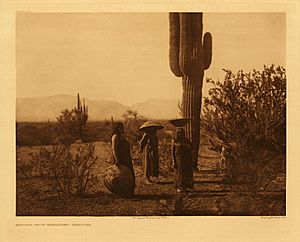
The Salt River Pima–Maricopa Indian Community is a special place in Arizona. It is home to two different Native American tribes. These are the Pima (who call themselves Onk Akimel O'odham, meaning "Salt River People") and the Maricopa (who are called Xalychidom Piipaash, meaning "people who live toward the water").
This community was officially created a long time ago. It happened on June 14, 1879, by an order from a US President named Rutherford B. Hayes. The community covers a large area of land, about 53,600 acres. A big part of this land, 19,000 acres, is kept as a natural preserve. As of 2022, about 7,386 people live here. This community is a federally recognized tribe, which means the US government officially recognizes them.
The community is located right next to several cities in Arizona. These cities include Scottsdale, Mesa, Tempe, and Fountain Hills. The official symbol of the Salt River Pima–Maricopa Indian Community is a picture of I'itoi. This symbol is often called the Man in the Maze.
Contents
Community Businesses and Activities
The Salt River Pima–Maricopa Indian Community runs several businesses. These businesses help the community grow and provide jobs.
Fun and Entertainment
Since the late 1900s, the community has opened two casinos. These are called Talking Stick Resort and operate under the "Casino Arizona" name. People from nearby cities and tourists visit these casinos. There are also offices and a large outdoor shopping center. This center is called The Scottsdale Pavilions. It has many well-known stores.
Sports and Recreation
In 2011, the community opened a special baseball complex. It is called Salt River Fields at Talking Stick. This is the first Major League Baseball spring training place on Native American land. It covers 140 acres. Two famous baseball teams, the Arizona Diamondbacks and the Colorado Rockies, train here in the spring.
Making Cement
The community also owns and runs the Phoenix Cement Company. This company makes cement and other building materials. It supplies these products to northern Arizona and the Phoenix area. Their factory is in Clarkdale. It is one of only two big cement makers in Arizona.
Roads and Travel
A major freeway, Loop 101 (also known as the Pima freeway), goes through the community. This road helps people travel north and south. The community has control over the land around the freeway exits. This allows them to plan new developments. The roads inside the community usually follow the same pattern as nearby cities like Phoenix and Scottsdale. Many are two-lane roads. Some parts are wider to handle traffic for the casinos and other businesses.
Speaking Their Languages
The Salt River Pima–Maricopa Indian Community works hard to keep its languages alive. These languages are Akimel O’odham and Xalchidom Piipaash. The community encourages everyone to learn and use these languages. They want families to speak them at home.
Some people who work for the community take language classes. This helps them understand the community and its people better. Many people want to learn their own culture's language. They want to pass it on to their children. Others learn to understand their family members better. People are working to make sure these languages continue to be spoken.
How the Community is Governed
The Salt River community has its own government. It is led by an elected President, Vice President, and Tribal Council. This system was set up in 1940. It followed a federal law called the Indian Reorganization Act.
Currently, Martin Harvier is the President and Ricardo Leonard is the Vice President. The Tribal Council members help make decisions for the community. They include Archie Kashoya, Cheryl Doka, Diane Enos, Thomas Largo, Sr., Deanna Scabby, Michael Dallas, Sr., and Wi-Bwa Grey.
The Man in the Maze Symbol
A very important symbol for the Salt River Pima–Maricopa Indian Community is the Man in the Maze. It is also called I'itoi ki:k. You can see this symbol on their official seal. This old pattern shows the journey a person takes through life. It includes all the challenges and problems they might face.
The figure in the maze is called Elder Brother. He is about to go through the maze. In the middle of the maze, he will find the Sun God. The Sun God is there to welcome him into the next world. This symbol is important to the Akimel O’odham (Pima), Pee-Posh (Maricopa), and Tohono O'odham tribes. You can find it in ancient rock carvings (called petroglyphs) and on traditional basket designs.
Community History and Places
The community has a cemetery near E. McDowell Road. It is a place where community members are laid to rest.
The Salt River Pima-Maricopa Indian community is also home to a very old Native American church group. This group belongs to the Church of Jesus Christ of Latter-day Saints. In 1997, a leader named Gordon B. Hinckley spoke at a ceremony there. He encouraged people to renew their lives and do good things. A nearby visitors' center also shows the history of the Salt River community.
Images for kids


